Raising Water Consciousness through
World’s Biggest Photo Exhibition and
Largest collection of Photo Stories on Water
Photo Stories | Drinking Water A story based on the theme of World Water Day 2019
Industry and Violation of the Human Right to Water in Bichhadi, Rajasthan
Nandita Singh and Om Prakash Singh
31 October, 2019
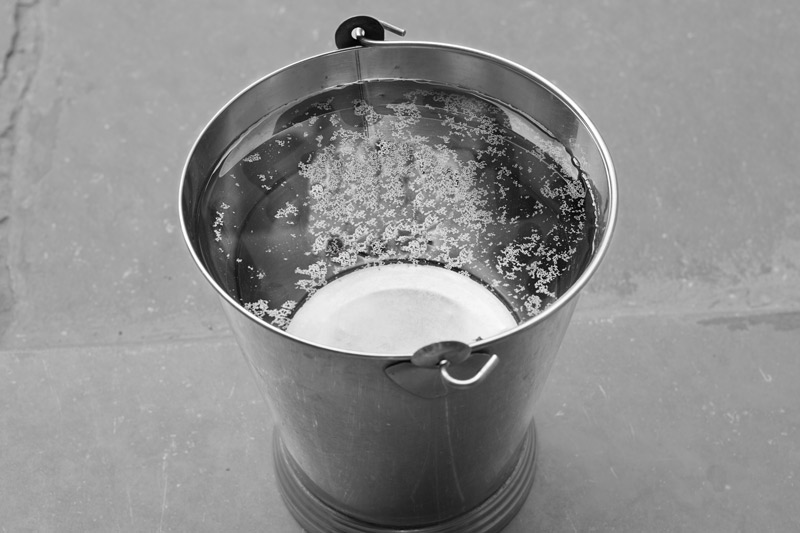
The human right to water is a critical instrument towards achieving the Sustainable Development Goal (SDG) of ensuring universal and equitable access to safe and affordable drinking water for all by 2030. In the context of India, a previous photo story (dated 16 April 2019) has highlighted the relevant norms and standards set out in the country for enabling progress towards enjoyment of the right. However, as illustrated in a series of photo stories published between May and September 2019, the status of enjoyment of the right doesn't appear very satisfactory in urban as well as rural India and many fail to enjoy their human right to water due to varied circumstances. Industrial development presents a setting which has the potential to seriously interfere with enjoyment of the human right to water because of severe consequences for local water resources and environment, most importantly through discharge of effluents and use of large amounts of water. Under such circumstances where water resources become contaminated or depleted, access to safe and adequate drinking water can become a huge challenge for local communities. According to estimates from the Central Pollution Control Board (CPCB), the number of rivers in India defined as "polluted" have more than doubled between 2011 and 2015, increasing from 121 to 275, disposal of untreated industrial effluents being an important reason. In 2017 CPCB estimated that as much as 501 million liters per day (MLD) of effluents was discharged by 764 grossly polluting industries into Ganga river alone. Examples of such industries include cement; dye; pulp and paper; aluminim, copper and zinc smelters; sugar; oil refinery; tannery; and thermal power plants. Industrial effluents may contain a variety of toxic components in large concentrations such as sulphur, naphthol, chromium, magnesium, phosphate, nitrate, fluoride, phenol, oil and grease, besides heavy metals like arsenic, cobalt, iron, copper, mercury, manganese, zinc, lead, cadmium, nickel, and certain auxiliary chemicals. After a revised categorization of industries in India in 2016, currently 85 industries are classified as 'red' and another 73 as 'orange', based on the seriousness of their negative impact on environment and water. It is obvious that enjoyment of the human right to water in areas where such 'red' and 'orange' industries operate could become seriously thwarted, since ordinary drinking water treatment processes are unable to remove the toxic chemicals such as those noted above. This photo story presents the plight of a village called Bichhadi in Udaipur district, Rajasthan, where the human right to water of the residents has been violated for decades through serious onslaughts on their water resources from industrial units located in and near the village. Located only about 20 km towards East from the District headquarters Udaipur, drinking water sources in Bichhadi have come to be severely polluted through operation of an adjacent zinc smelting unit at Debari since 1968 which is owned by Hindustan Zinc Limited (HZL). In addition, during the 1980s, establishment of five chemical units owned by Hindustan Agro Chemicals Limited and its subsidiaries within the village territories added to people's water woes. Though the latter five units came to be eventually shut down under orders from the Supreme Court of India, HZL continues its operations at an expanded scale, seriously thwarting people's access to safe drinking water. It is noteworthy that HZL as well as the above-mentioned chemical industries in Bichhadi all belong to the 'red' industrial category. The title photo shows greasy layer formed on the top of a bucket filled with water from a tanker in Bichhadi. The tanker supply is organized by HZL.
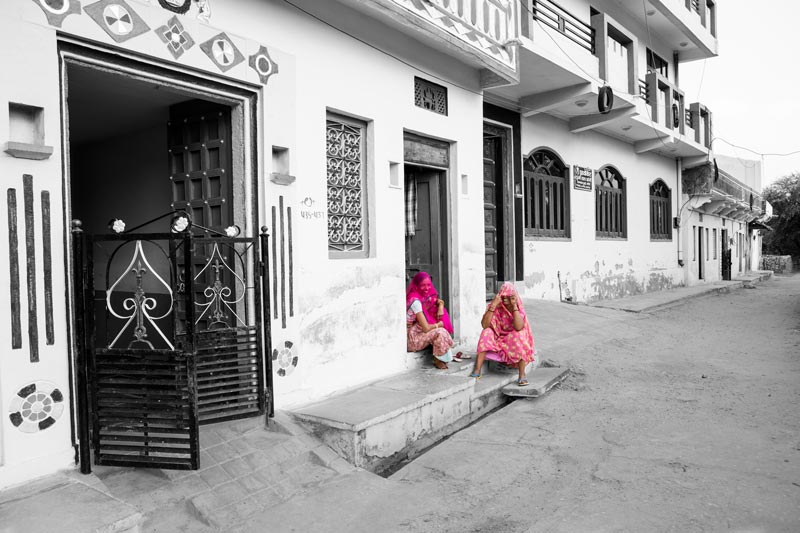
A view of the village settlement in Bichhadi
Bichhadi is a large village where, according to the Census of 2011, a population of 4,295 resides in 919 households. The village is spread over an area of 596 hectares and the households are distributed in nine 'mohallas' or localities. The population density is high, being more than 700 persons per square kilometer, which makes the village qualify to be reckoned as an urban area. It is the headquarter of Bichhadi Gram Panchayat, which also includes the neighboring villages of Sinhara and Singri. The village is located adjacent to the zinc smelting unit of HZL at Debari, lying primarily towards the East. Its territory borders the tailings dam of the zinc smelter operated by HZL and the human right to water of its residents has been thwarted for more than five decades due to its operation.
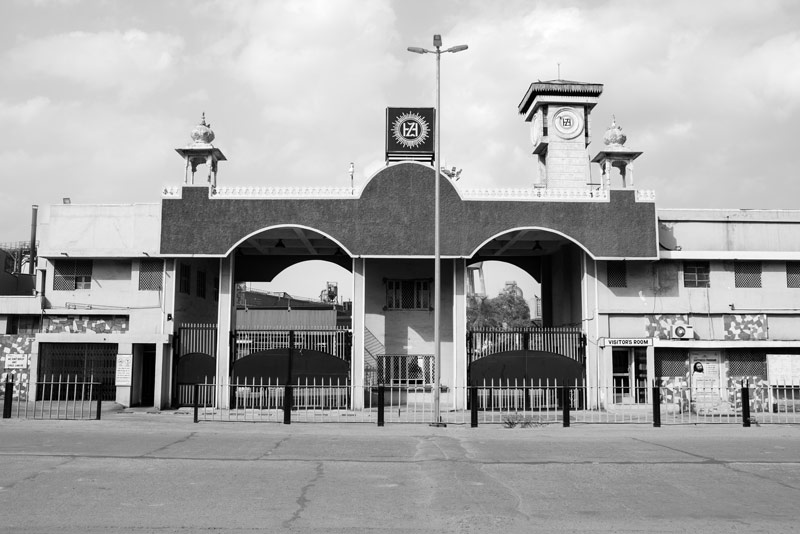
The main entrance to the industrial complex of the Hindustan Zinc Limited at Debari
HZL is India's largest and world's second largest zinc-lead mining industry. Originally a State-owned company, today it is a subsidiary of Vedanta Limited which owns 64.9% stake in the Company while the Government of India retains 29.5% stake. The transition from a public sector undertaking to private sector took place in 2002-2003. HZL's mines are located at several places in Rajasthan, and the current ore production capacity is 12 million tonnes per annum. For extracting zinc from the ore, in Rajasthan HZL has three smelters, located at Debari, Chanderiya and Dariba. The one at Debari, the main entrance to which is shown in the photo above, is located about 14 km east of Udaipur, and happens to be India's oldest zinc smelter.
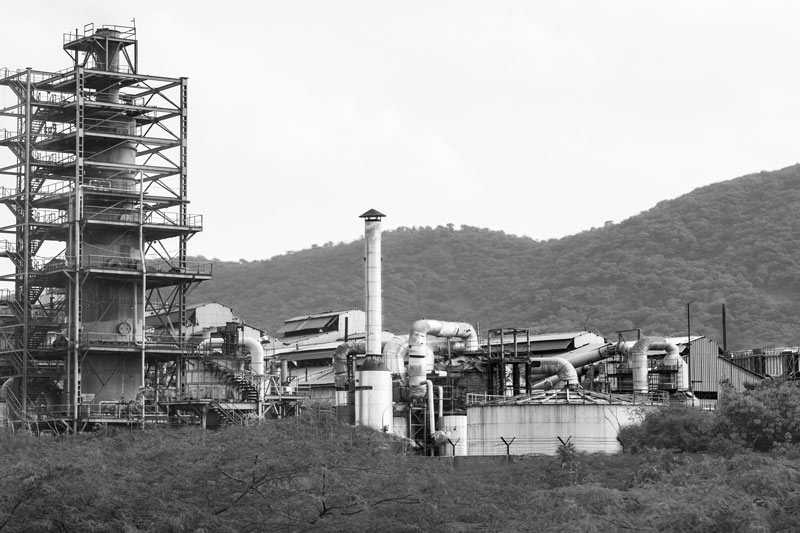
The Zinc Smelter of Hindustan Zinc Limited at Debari
The zinc smelter at Debari, shown in the photo above, has been operational for more than 50 years. Zinc, with use in a number of important applications including galvanising, oxides, die castings and alloys, is a metal in high demand within India and outside. For meeting the increasing demand, the production capacity of the Debari zinc smelter has been upgraded manifold over the years. Against an initial annual production capacity of only 18,000 tonnes, its capacity has expanded five folds to its current capacity of 88,000 tonnes per annum. The smelter uses the hydrometallurgical smelting process which apart from producing zinc, also leads to effluents and waste commonly containing metals such as arsenic, antimony, cadmium, cobalt, germanium and nickel, besides zinc itself, all of which are known to have negative health impacts for humans beyond a tolerable limit. Also, jarosite containing high proportion of iron is produced as a byproduct during the purification and refining of zinc which is a highly acidic sludge-like material.
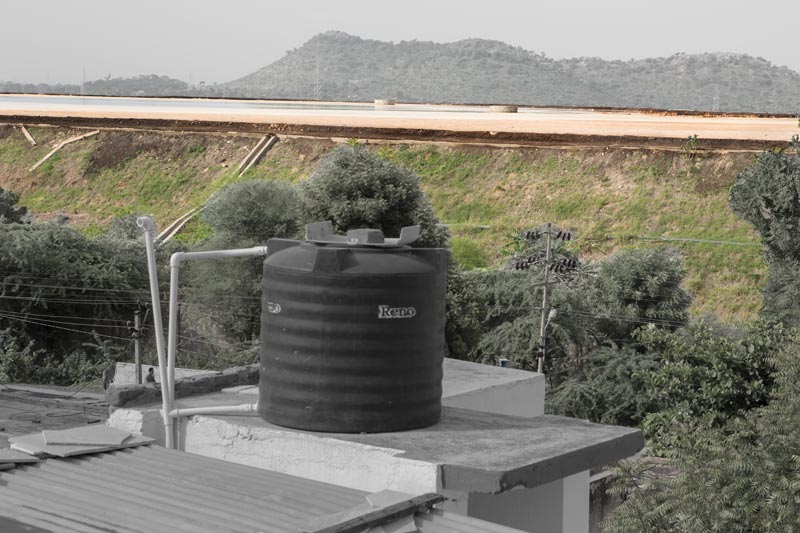
A tailings dam at the Debari complex of Hindustan Zinc Limited containing highly toxic byproducts from the zinc smelter
A tailings dam is an earth-fill embankment generally used for permanently storing byproducts of mining and ore processing operations, which are usually highly toxic liquid, solid, or slurry of fine particles. At the Debari zinc smelter, a large tailings dam in the form of a jarosite pond, shown in the photo above, has been created to systematically store jarosite and other toxic byproducts emerging from the zinc smelting process. The current height of the embankment of the pond is 17 m and its current storage impoundment volume is 9 million cu.m. The pond is claimed to be completely sealed and protected from all sides, with no risk of pollution to the surrounding environment. However, it is noteworthy that the jarosite pond shown above lies adjacent to the agricultural fields belonging to residents of Bichhadi. The villagers contend that during the rainy season, excess water collected in the pond is just released which then flows out into the village, contaminating their water resources and soil.
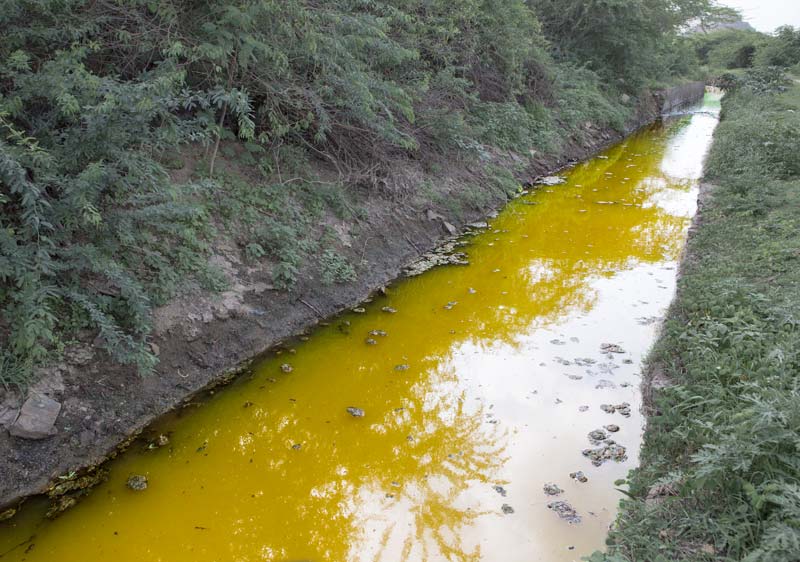
Colored effluent from Debari zinc smelter flowing through an irrigation canal in Bichhadi
HZL claims to follow a "zero discharge" policy and therefore fully treat all effluent before releasing into nature. In response to a complaint lodged by the villagers against the company, HZL claimed that the effluent emerging from the zinc smelting process is treated in an effluent treatment plant (ETP) located inside the complex before being released. The treatment capacity of the ETP is said to be 5,760 cu.m. per day, much more than the actual effluent production. However, colored water in an irrigation canal that flows along the boundary wall of Debari complex, through the fields of village Bichhadi negates this claim, as testified by the photo above. This canal originates from the adjacent Udai Sagar Dam and flows across and beyond Bichhadi through 37 kms, distributing irrigation water to all the villages on its way during the months of November to February. Rest of the year, its bed is supposedly empty and dry. However, this photo taken in July shows the canal to be nearly full of water and that too colored water. This is a testimony to the fact that untreated effluent from the zinc smelter is being released by HZL into neighboring water bodies. Effluent from zinc smelters is known to contain cadmium and other contaminants, including iron. The yellowish color of the water seen in the photo is indicative of the presence of these contaminants.
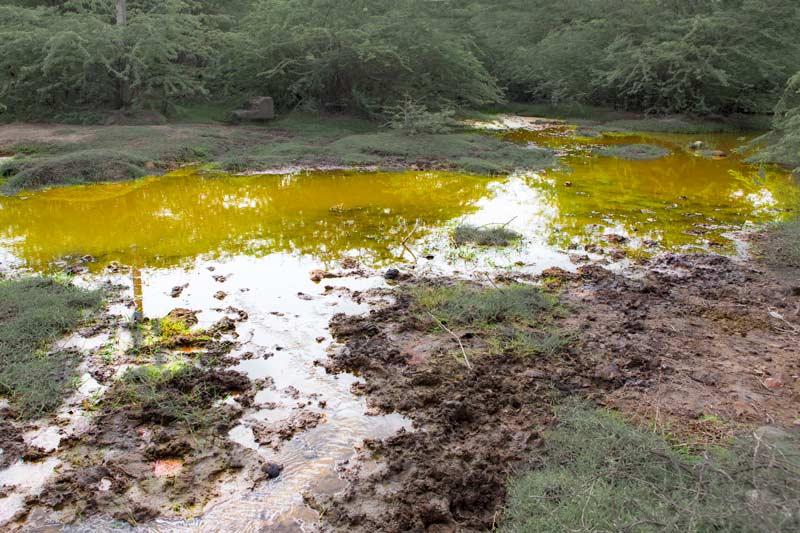
Effluent from the irrigation canal shown above spreading out in the fields of Bichhadi
The effluent carried in the irrigation canal mentioned earlier contains toxic components that get deposited in agricultural fields and pasturelands of Bichhadi and beyond, as shown in the photo above. These further find their way into the surface and groundwater resources.
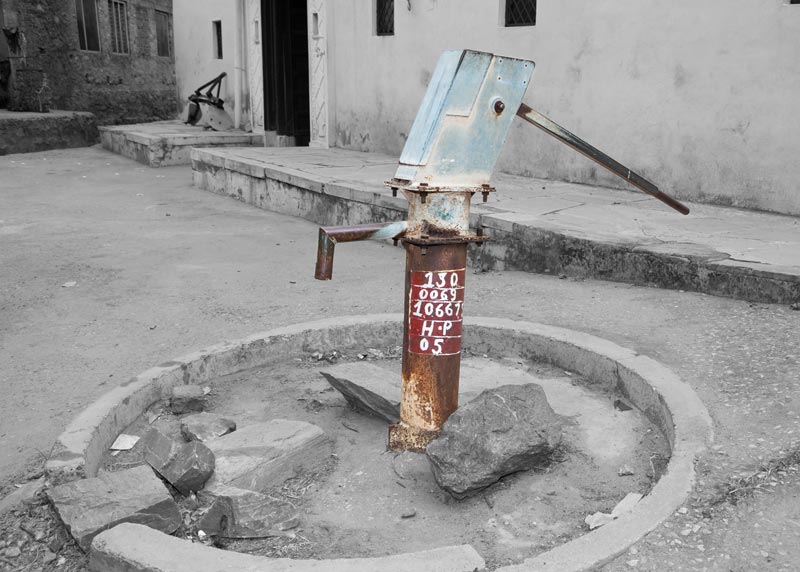
A red-marked handpump in village Bichhadi indicating unsuitability for drinking
According to the residents of Bichhadi, the quality of groundwater in the village has increasingly deteriorated over the decades due to pollution emanating from the zinc smelter. There exist over 25 public handpumps in the village, all of which have been rendered non-potable. The handpump shown in the photo above has been marked red to indicate the unsuitability of the water for drinking and cooking. Similarly, there also exist about 60 wells within the village habitation and the fields, from where drinking water was drawn in the past. However, these have been abandoned for drinking and cooking purposes due to contamination. According to villagers, the water quality in the handpumps and wells of Bichhadi came to be tested in 1996-97, following complaints about water quality problems and health issues, and also ongoing litigations involving Hindustan Agro Chemicals Ltd. mentioned earlier. The test reports confirmed problems with water quality in the shallow aquifers and consequently, all the existing drinking water sources in Bichhadi came to be abandoned.
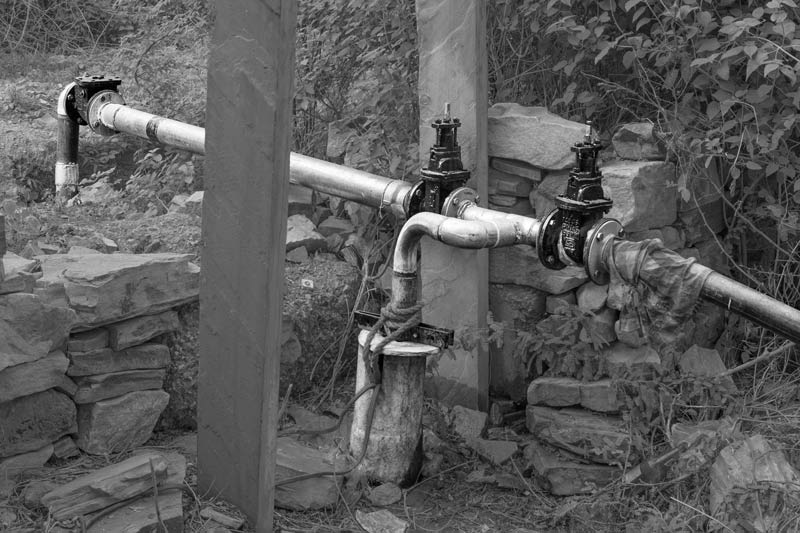
A tubewell supplying contaminated piped water to Bichhadi
Following closure of the handpumps and wells of Bichhadi for drinking and cooking, for supplying safe water, a new well was dug more than 20 years ago on the banks of river Berach that flows through the village. It was assumed that since the river recharges the shallow aquifer here, the water would be safe. The water supplied from this well filled a large tank in the heart of the village from where people could collect drinking water through a public standpoint. However, soon this well water also came to be reported as contaminated, and a deep tubewell was installed at the same spot, from which household-based pipeline supply was drawn. For the last several years Bichhadi is served by a groundwater-based piped water network fed by 4 deep tubewells located in different corners of the village. The depth of these tubewells is 350-400 feet. Drinking water can be collected from taps within households as well as public tanks. However, the people are not happy about the quality of the water available, because now even the deeper aquifers are polluted, and the water supplied is not seen as fit for drinking and cooking. The level of total dissolved solids (TDS) in the groundwater is 2,500 mg/l, against a maximum desirable level of 300 mg/l and maximum permissible limit of 600 mg/l, as stipulated by the Bureau of Indian Standards (BIS). One of the deep tubewells supplying piped water to the village is shown in the photo above.
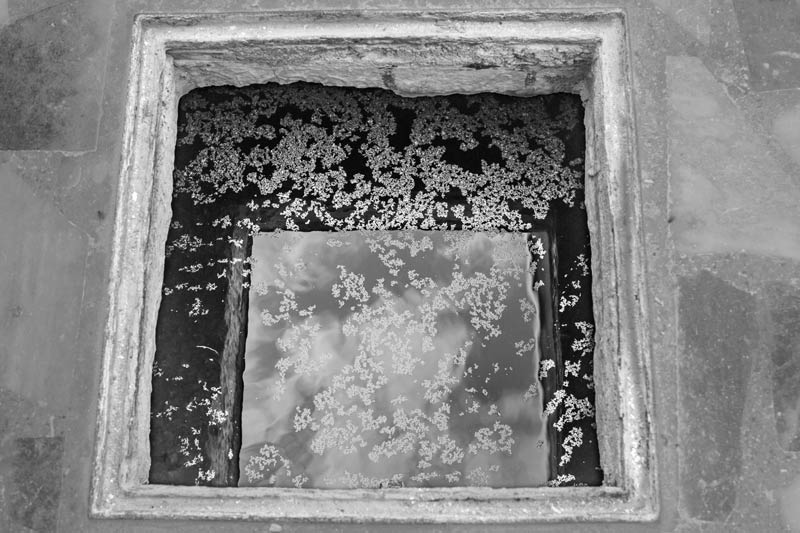
An underground household tank filled with water from the pipeline supply showing a thin greasy particulate layer
The water supplied by the village tubewells through the pipeline is commonly stored by the people in underground and overhead tanks since the supply is at an interval of 2-3 days. However, though generally colorless, a partly shimmering greasy layer often forms on the top immediately after filling a container or a tank, an example of which is shown in the photo above. According to scientific reports recognized by the World Health Organization, drinking water containing zinc at levels above 3 mg/litre tends to be opalescent and develop a greasy film when boiled, and also have an undesirable astringent taste. On this basis, it may be suspected that the groundwater supplied from the village tubewells in Bichadi contains substantial amounts of zinc, besides other contaminants.
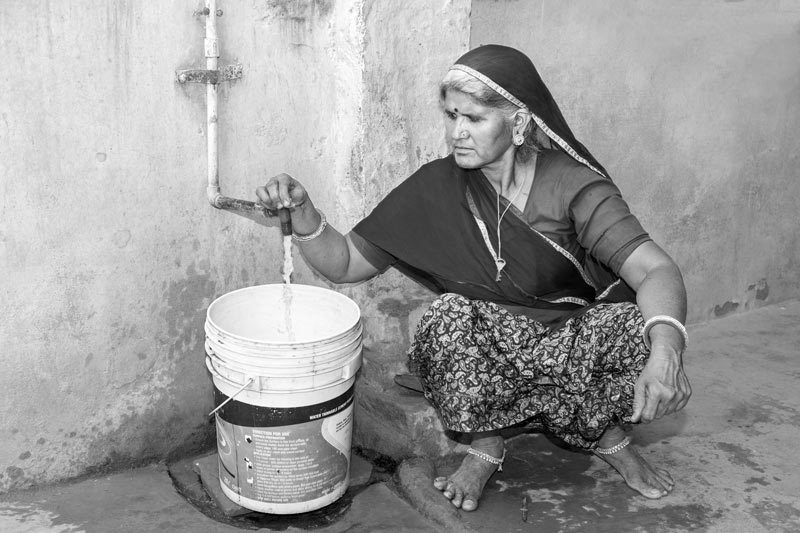
Logri Bai, 50 years, filling bucket with water sourced from the tubewell-based pipeline supply
According to Logri Bai, resident of Bichhadi, the water from the pipeline supply has been problematic for several years. In the photo above, she fills a bucket with water drawn from an overhead tank in her house that is connected to the pipeline supply to display how within minutes, a thin greasy layer containing suspended particles appears on the surface. The water quality from the pipeline is perceived to be so bad that it can be used for only washing, bathing and drinking by animals. Logri Bai complaints that given the degraded water quality, organizing any social function at home such as marriage brings extra expenses since tanker needs to be ordered from outside. A closer view of the pipeline water filled by her in the bucket is shown in the next photo.
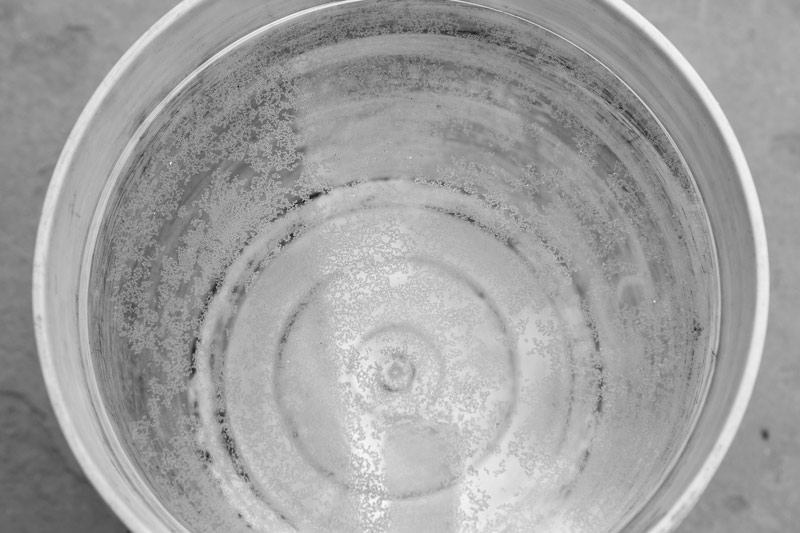
Water in the bucket filled in the previous photo showing a thin greasy top layer having particulate matter
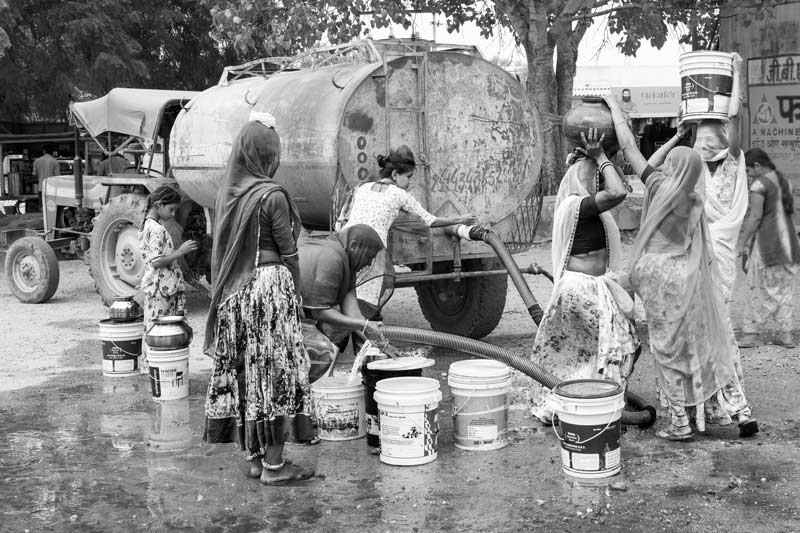
Drinking water being supplied by HZL in Bichhadi through tanker
In response to the drinking water woes of the villagers and their initial protests, HZL started supplying treated drinking water from their compound through public tapstands on their boundary and in Bichhadi and other neighboring villages through pipeline. This was the scenario through the 1990's, and the water quality is said to have been good and sufficient enough for fulfilling people's drinking water needs. However, after privatization in 2002-2003, the tapstands no longer functioned and drinking water supply came to be organized through tankers. Thus, started serious problems with drinking water access in the village because the supply has since been irregular and insufficient. However, the quality of the supplied water was initially good – being the same as that supplied to HZL's employees within the compound. Over the last 5-6 years, this used to be treated river water supplied from Mansi Wakal dam. However, since May 2019, the villagers have noticed sharp deterioration of the water quality, making safe water access an acute problem. The water supplied presently is saline, unclean and gets the same kind of greasy top layer on storage as it happens with the groundwater-based pipeline supply. So, they assume that the tankers are filled with groundwater from a local source rather than treated water from Mansi Wakal dam. However, in the absence of an alternate known safe water source, people continue to depend on the tankers for drinking water, braving through health issues like indigestion.
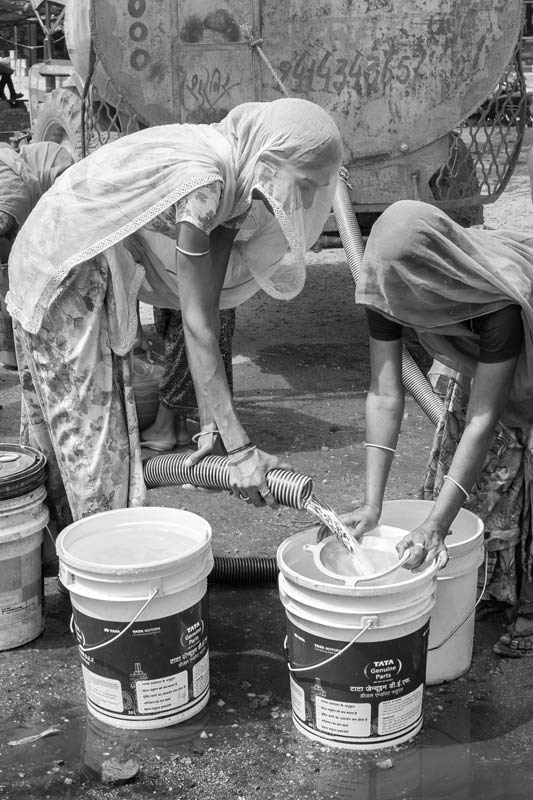
Unclean tanker water being collected, using a filter to clear the contamination
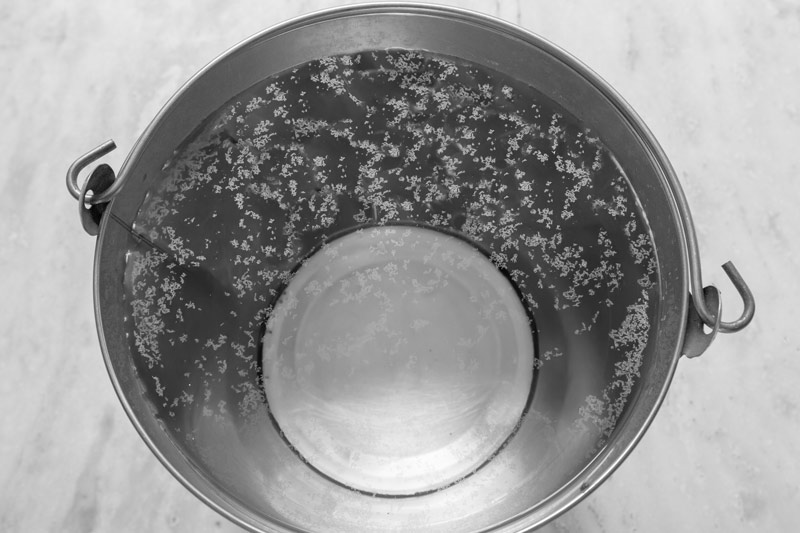
Tanker water kept in a bucket, showing a fat greasy particulate layer on top within an hour
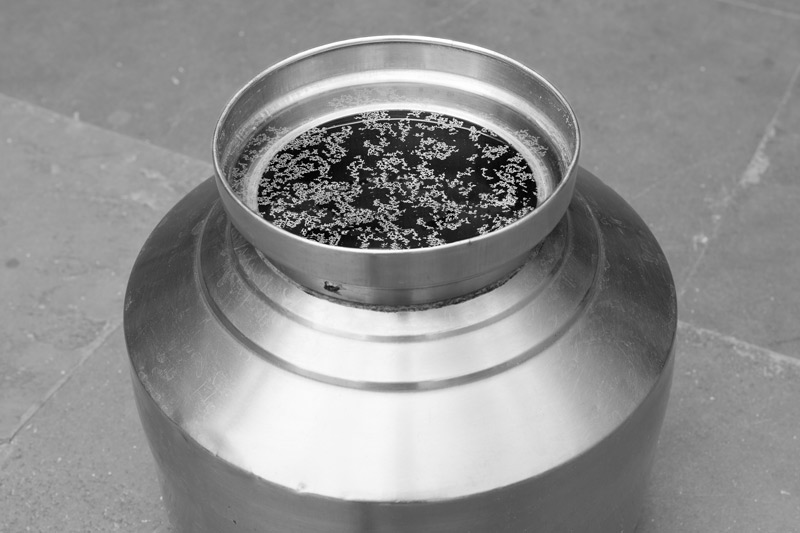
Drinking water from the tanker stored in a pot, showing a fat greasy layer on top within an hour
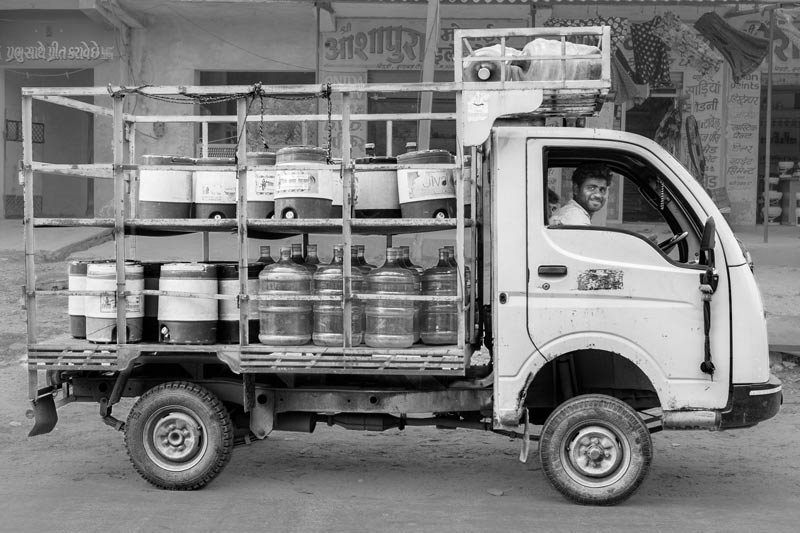
Safe water from a reverse osmosis (RO) plant being privately supplied in Bichhadi
As described before, the water supplied through the piped network is unsafe, and so is the tanker water. Consequently, some households have switched to private RO water supply. Local private enterprises in the area engage in purifying groundwater through RO treatment and supply the water in 15 liters cans (locally called 'camper') and 20 liters jars, at a price that could vary between Rs. 20 (approx. 0.3 USD) per camper to Rs. 30 per jar (approx. 0.4 USD). The water is supplied on a daily basis. In Mangri mohalla, one of the localities of Bichhadi, about 20 households out of a total of 125 receive a fixed monthly supply of RO treated water, and in the village as a whole, about 10-15% households buy such RO water. While the people are happy with the quality of this water, they complaint of the extra cost that this alternative brings, and everyone cannot afford it. In fact, during summer season, the RO water becomes even more expensive.
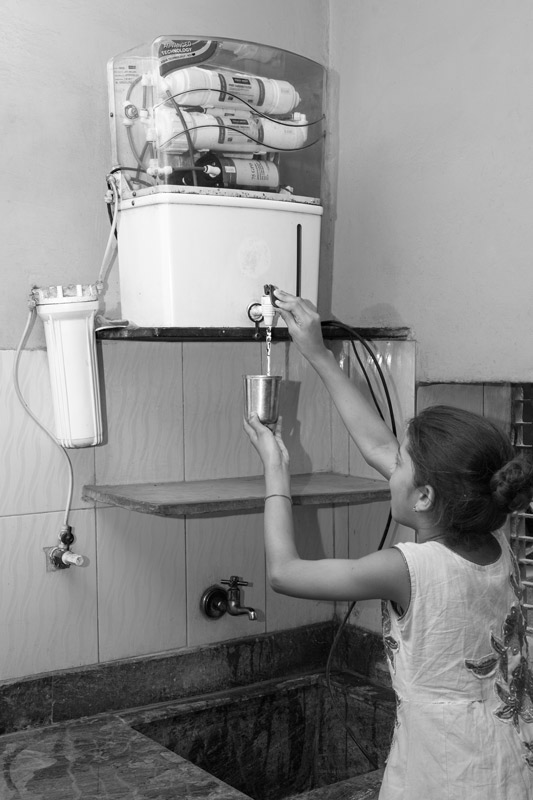
RO unit at home used for purifying the supply water
Considering the non-potability of groundwater and tanker water, some households have installed individual RO units. However, RO unit is expensive, costing Rs. 14,000-20,000 (approx. 198-282 USD) and therefore, very few can afford it. Moreover, even those that have invested this large sum in the hope of drinking safe water, are dissatisfied because the high TDS in the water reduces the efficiency of RO. The filter needs to be changed every 1-2 months, costing Rs. 200 (approx. 2.8 USD) every time and travel to the capital city Udaipur. This implies increased expenditure as well as inconvenience in ensuring access to safe drinking water at home. In Mangri mohalla alone, about 10 households possess individual RO units, but none function regularly.
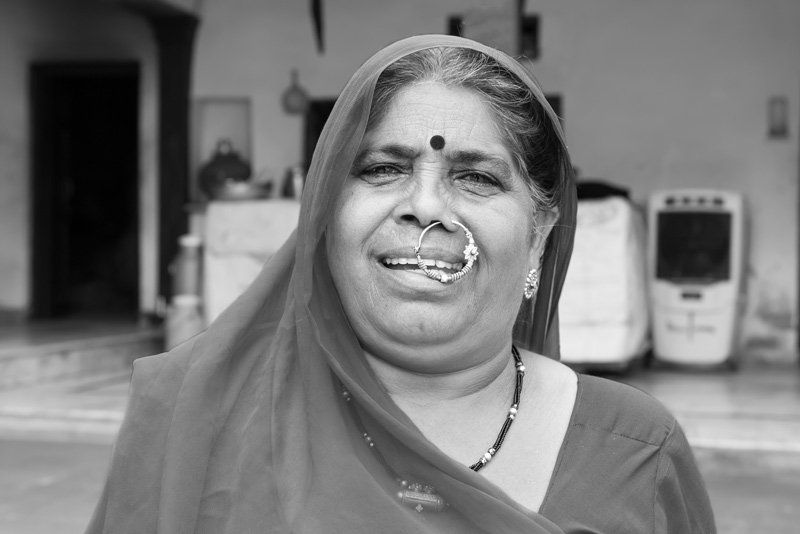
Chandri Bai, aged 55 years explaining the problems regarding health challenges resulting from contaminated drinking water in Bichhadi
Chandri Bai has lived in Bichhadi for several years and witnessed the gradual deterioration of the drinking water quality and its impact on people's health. According to her and other women, stone in the gall bladder or kidneys is a common ailment that has come with the water contamination. Almost every household has 1-2 such cases – men as well as women - and there are several persons who have had stone more than once in their lifetime. In addition, problem in the uterus is common among women, leading to its surgical removal in many cases. The number of such women in the village is large. Children's growth is also adversely affected, and the fertility of cattle and other farm animals is greatly reduced. Chandri Bai further explains that even the quality of tanker water is bad, but in the absence of any better choice, people fight over even one bucket of water from the tanker which arrives only twice a week at a single delivery point, there being a number of such points in the village.
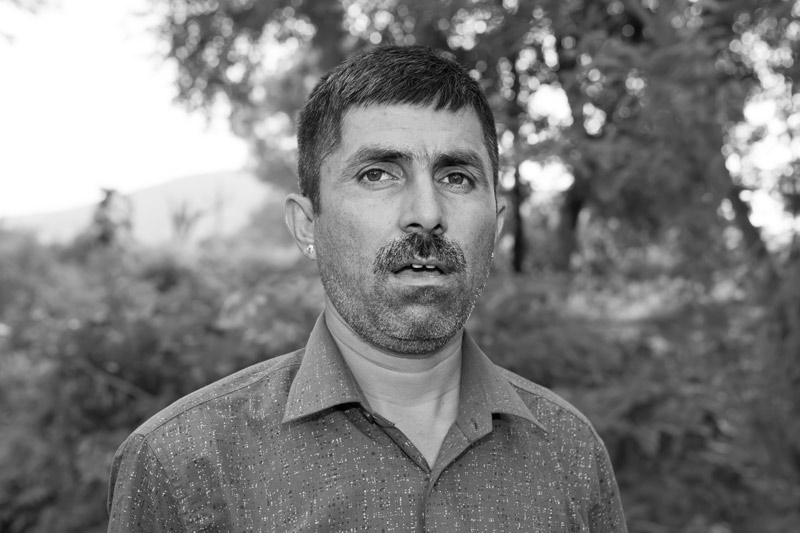
Kamal Singh, aged 38 years, Ex-Sarpanch of Bichhadi Gram Panchayat
As the Sarpanch of Bichhadi Gram Panchayat (GP), Kamal Singh has played an active role in Bichhadi's struggle against HZL during his tenure between 2011 and 2015. According to him, the struggle has spanned over five decades but the problem remains acute. Effluent and seepage from the zinc smelter has systematically eroded people's access to clean and safe water, making them unhealthy. Also, their environment and livelihoods are destroyed due to soil contamination and exposure of animals to contaminated water and fodder. He opines that transition of HZL from government-owned to private company has worsened the situation. He explains that several complaints and litigations have been moved against HZL, the latest being one in the court of the Sub-Divisional Magistrate (SDM) in 2008, demanding that the company be directed to stop release of untreated effluent into the village boundaries. In response, the SDM passed an order in 2014, directing HZL to immediately stop such release and also compensate the villagers for the damage done as per an evaluation by the villagers themselves. However, HZL pleaded innocence and filed an appeal in the higher court at Udaipur, decision on which is pending. Kamal Singh continues to protest, putting forward demands together with fellow villagers, but finds it dismal that there is yet no relief.
Based on the above narration, it is indisputable that the human right to water of the residents of Bichhadi has come to be systematically violated through operations of HZL's smelter at Debari. It is more than evident that all the norms set out as essential for enjoying the human right to water have come to be thwarted by the operations of this industry. First and foremost, the norm of 'quality' is violated since all the drinking water sources of the village have been rendered unsafe by the smelter's untreated wastewater. Substitute drinking water supply presently provided by the company through tankers is equally unsafe. Though there is enough water in the village for fulfilling domestic and personal needs of non-drinking nature, with tapwater connection in almost every household, the 'availability' norm is still seriously thwarted because continuous supply of safe drinking water is neither available in the house nor outside. Further, irrespective of the quality, the tanker water supply is irregular and inadequate given the large population, which together violate 'availability' as well as 'physical accessibility' norms for drinking water. Absence of safe drinking water supply from the company or any government agency makes people fall back upon private agencies for the same, which in turn ends up thwarting the 'economic accessibility' or 'affordability' norm as the alternatives in the form of domestic RO filter or RO treated water cans is expensive, and cannot be afforded by the masses. Even an installed domestic RO unit is wasteful because of the highly degraded groundwater quality. Further, there is violation of the 'non-discrimination' norm since the entire village community is affected by the industrial operations but denied the opportunity to fulfil even their basic human needs. Nor is participation of the affected sought in decisions regarding the exercise of their human right to water, and the villagers contend that HZL does not listen to their voices. Currently, they are demanding installation of a RO plant at a new 350,000 liters tank that has been set-up by HZL for gravity-based supply of tubewell water to the village. However, the company doesn't want to invest more, and business continues as usual. Also, the norm of 'information accessibility' is thwarted since there exists no information dissemination about the real impact of the company's operations on people's water and environment, and instead, what exists is misinformation such as 'zero-discharge' and 'safe tanker water supply'.
From the above account, it is obvious that neither the company nor the government today fulfills their obligations to ensure enjoyment of the human right to water by the villagers of Bichhadi. HZL's annual compliance reports to government regarding stipulated conditions for environmental clearance show a 'zero-impact' status, and its project proposal for expansion of the smelter operations in 2017 declares the industry as 'environment-friendly', bringing multiple 'economic and social benefits' to the local community, region and the state of Rajasthan. However, the above account from Bichhadi paints an opposite picture. Sustainable development is not possible without enjoyment of the human right to water, and without securing the environmental pillar of sustainability. In fact, a retired employee of HZL pointed out that when the company was State-owned and people started protesting over degradation of their water resources and environment, the company pacified them by providing few jobs, but today after more than 40 years, the result of ignoring the community's demands is more than evident.
India has strong environmental laws and regulations, including a well laid-down procedure for environmental impact assessment. However, it is evident that in this case, all concerned laws, rules and regulations have been kept at bay, and the government has failed to fulfil even its basic obligations for securing people's human right to water. For example, as laid down in the human right to water framework, under the obligation to 'respect', the government should have refrained from interfering directly or indirectly with the enjoyment of the human right to water through its acts of commission in the past (when HZL was a State-run company) and acts of deliberate 'omission' at present. Moreover, the government fails to fulfill the obligation to 'protect' the people's right which required it to prevent third parties (in this case, HZL) from interfering in any way with the enjoyment of the right. It is obvious that neither the Rajasthan State Pollution Control Board (RSPCB) nor the CPCB, nor allied governmental agencies or even the court of law are taking adequate, appropriate and timely measures towards this end. Finally, the government also fails to 'fulfil' the right of the people by, for example, 'facilitating' the community through positive measures, and 'fulfilling' (providing) the right when the people are clearly unable, for reasons beyond their control, to realize the right themselves.
Bichhadi's story is not unique. It is representative of hundreds and thousands of such narratives in India where the human right to water of local communities has been violated through industrial onslaughts without any respite. It is high time that concerned authorities wake up to the cause, and complying with their statutory obligations, ensure that affected people's rights are restored on a short-term as well as long-term basis, and appropriate actions and obligations are imposed on the violators and their compliance ensured through efficient monitoring. Fulfilment of the human right to water of such aggrieved communities is quintessential because otherwise their concomitant rights such as to health, livelihoods, education, and over-all socio-economic development get thwarted through multiple pathways. Furthermore, as the environment and water resources in these communities get affected, even far-off communities are exposed to health risks through export of contaminated crops and food products. This complex of processes ultimately impact progress towards sustainable development at local, regional and national levels.